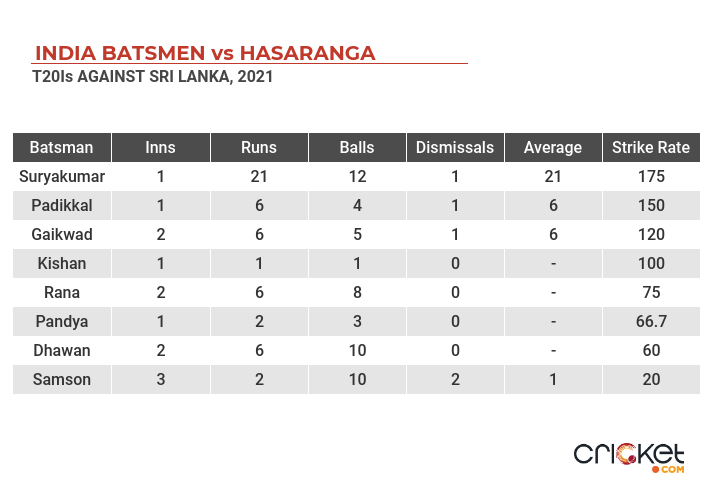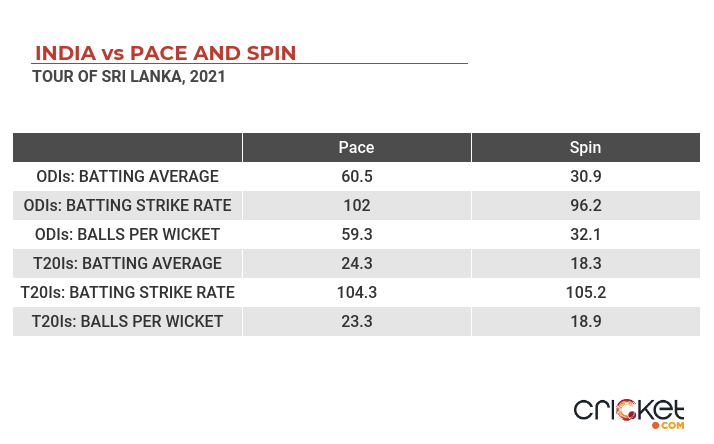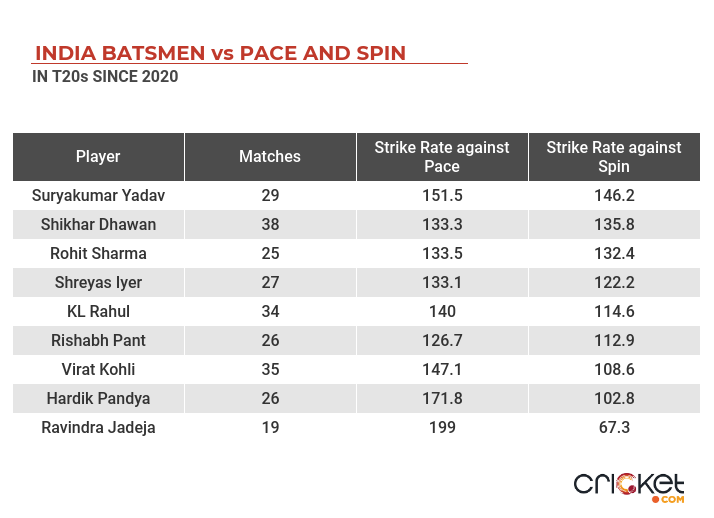 ANALYSIS
ANALYSISEnglish cricket analysts have been the trendsetters on the usage of data and match-ups. Hence it was not surprising when in the first T20I during England’s tour of India earlier this year, Adil Rashid opened the bowling. Both Indian openers had the lowest T20I strike rate against leg-spin and even their captain – in at three – has a significantly lower strike rate against spin as compared to pace. India were two down inside three overs. The plan worked. Rashid ended that series with an economy of 7.8, the best among any of the spinners from both sides.
Since the England series, the current tour to Sri Lanka has been the only white-ball series India have been involved in. A blitzkrieg from Prithvi Shaw started the tour with the most one-sided ODI for India in recent memory. In a 24-ball 43, he skied the first ball he faced against spin to long-on. Perhaps, that gave Sri Lanka a cue to nullify the Shaw threat.
In the second ODI, Wanindu Hasaranga bowled the third over. Shaw failed to read the googly that headed for his stumps as a delivery from Hasaranga often does. The all-rounder ended the night with wickets of Shikhar Dhawan and Krunal Pandya too at crucial junctures. He almost won the game for his side if not for a lower-order fightback from India.
Hasaranga sat out in the third ODI but Sri Lanka added multi-skilled spinner in Akila Dhananjaya and Praveen Jayawickrama, a slow left-arm option, for a plethora of right-handers in India’s line-up. The pair finished with 6 for 103 in the match, paving the way for Sri Lanka’s victory.
In the T20I series, Hasaranga continued tormenting the Indian batsmen. The issue with facing Hasaranga is that a) while most spinners bowl a googly with the back of their palm towards the batsman, he bowls it with a lot of the ball visible like in a conventional leg-spin and b) a high proportion of his balls hits the stumps bringing a lot more dismissal types into play.
A Twitter handle @CricketWithAsh explains this further, with the help of observations made by Nasser Hussain on air for Sky Sports last month.
Wanindu Hasaranga - what makes him succeed?
— Cricket With Ash (@CricketWithAsh) July 22, 2021
[If deleted, watch it here : https://t.co/ugF51Vm6G9] pic.twitter.com/RSmWOiOh7A
Hasaranga ended the T20I series as the leading wicket-taker. The only Indian batsman who has able to read his variations and counter him to an extent was Suryakumar Yadav, who is also the best player of spin bowling in India by a distance.

Not that Hasaranga was the only factor. In both ODI and T20I series, Indian batsmen not only scored runs slower against spin but also lost wickets more frequently. This goes against the trend in overall T20 cricket where spinners do go for fewer runs per over than pacers but also take wickets at a slower rate.

Now some might argue that India missed their key batsmen in the last two T20Is. It is not an illicit argument. But players like Devdutt Padikkal and Sanju Samson are in the mix for a World Cup berth and moreover, the series against Sri Lanka was a chance to put the players in the fringe under a test. In T20s since, Samson has a strike rate of a mere 110.8 against googlies. Never once did he seem able to pick any of Hasaranga’s googlies. On the other hand, Padikkal has a strike rate of 84.3 against off-spin in the same period. With him and Shikhar Dhawan at the crease together in the second T20I, Sri Lanka deployed off-spin from both ends. It resulted in four quiet overs that went for 22 runs.
This is an era when batsmen practice range hitting as much as a forward defence. But this begs the question that how much of it is against quality spin?
In India’s case, the issue against spin is not limited to the next generation alone. Of all the batsmen likely to be among the first-choice picks for the World Cup squad only Surya, Dhawan and Rohit do not have a significant drop between their strike rates against pace and spin.

Of these, the strike rate against spin for Kohli, Iyer, Pant, and Jadeja is under a 100 on the first 10 balls. Most of these will bat after the powerplay with no advantage of field restrictions. Even for Hardik Pandya and Rohit Sharma, this number is around 110.
There are even further limitations of most of the Indian batsmen against a particular spin bowling or a delivery type. We live in times when every ball is an event analyzed more diligently than a whole session a couple of decades back.
The old guard of cricket experts frowned when Nathan Leamon, the analyst of the England team, sent signals from the dressing room for Eoin Morgan during their tour of South Africa in 2020. The teams that he works for use codes made up of a combination of an alphabet and a number to send a signal for the captain’s perusal. So while India should feel proud of their bench strength, there is work to be done if they are to get hold of an elusive ICC trophy.
A few minutes of madness have cost India on big occasions in recent years. Almost always this was due to seam bowlers in the opposition making the ball talk under a gloomy sky. As the T20 World Cup looms, the team with a proud history of dominance while playing against a turning ball should be ready to avoid a spin-induced collapse at a crucial juncture.